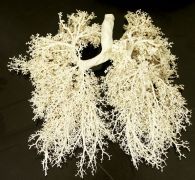Nintedanib Treatment Slows Disease Progression in Patients with Idiopathic Pulmonary Fibrosis
Results from two studies show that treatment with the novel kinase inhibitor nintedanib significantly slowed disease progression in patients with idiopathic pulmonary fibrosis (IPF). However, only one study showed nintedanib had any effect on slowing deterioration in quality of life or reducing the risk of a first acute exacerbation compared with placebo.

Results from two studies show that treatment with the novel kinase inhibitor nintedanib significantly slowed disease progression in patients with idiopathic pulmonary fibrosis (IPF). However, only one study showed nintedanib had any effect on slowing deterioration in quality of life or reducing the risk of a first acute exacerbation compared with placebo.
During a session yesterday at the 2014 American Thoracic Society International Conference, Luca Richeldi, MD, PhD, University of Southampton, UK, discussed results from the phase 2 TOMORROW trial, a dose-ranging, 12-month study in which the highest dose of twice-daily nintedanib 150 mg significantly reduced the decline in forced vital capacity (FVC) in patients with IPF over the course of the study compared to placebo. The drug was well tolerated with the main adverse events being gastrointestinal in nature (diarrhea, nausea, and vomiting were the most common).
He also discussed results from two other trials (INPULSIS-1 and INPULSIS-2) in which patients age 40 years of age and older with a diagnosis of IPF, with FVC ≥50% of predicted value, confirmed by HRCT, were treated with twice-daily nintedanib 150 mg. A final total of 513 subjects were treated in INPULSIS-1 and 548 subjects in INPULSIS-2.
The primary endpoint was the annual rate of decline in FVC in mL per year. Key secondary endpoints were change from baseline off St. George's Respiratory Questionnaire (SGRQ) total score over 52 weeks and time to first acute exacerbation over 52 weeks.
In INPULSIS-1, 309 patients were randomized to nintedanib and 206 to placebo, in INPULSIS-2, 331 patients were randomized to nintedanib and 220 to placebo. Some patients (20-30% in the nintedanib-treated groups) required an interruption in treatment and a similar percentage had their dosage reduced to 100 mg twice daily.
In both studies, more patients treated with nintedanib experienced less than a 5% decline at one year in predicted FVC compared to placebo (53% vs. 38% in INPULSIS-1, 53% vs. 39% in INPULSIS-2).
Results for patients experiencing a 10% decline or less in predicted FVC at one year of treatment were better in INPULSIS-1 (71% for nintedanib vs. 57% for placebo) compared to INPULSIS-2 (69% for nintedanib vs. 64% for placebo).
The time to first acute exacerbation and the change in SGRQ score over 52 weeks were not significantly different between the two groups in INPULSIS-1. The time to first acute exacerbation in INPULSIS-2 was significant at p=.0050 and the decline in SGRQ score over the study period was also significantly reduced in nintedanib-treated patients in this study.
Diarrhea was the most common adverse event in both studies, occurring in just over 60% for nintedanib-treated subjects and about 18% in placebo-treated patients.
In the follow-up discussion, one audience member commented that the study did not address elderly patients who are usually stable or patients (eg, with cancer) in the early stages of fibrosis. Richeldi said that 30% of the study subjects did not show honeycombing and the protocol may not have not have excluded all patients with emphysema. However, these populations might be studied in future.
Another questioner pointed out the 32 nintedanib-treated patients showed signs of liver toxicity compared to 3 in the placebo groups. Richeldi said the signs were mostly minor such as increased liver enzymes and he did not believe this represented real (clinical) toxicity.
On another point, Richeldi said while the screening failure rates were high (28% for INPULSIS-1 and 31% FOR INPULSIS-2), they were not that high in comparison to other clinical trials.
There was discussion about how the assessment committee determined the cause of acute exacerbations; whether due to deterioration of IPF or other triggers such as viral infection. Regarding racial characteristics, a high incidence of acute exacerbations predicted for Asian subjects did not materialize in these two studies. Richeldi pointed out that the INPULSIS trials were not powered for the secondary endpoints.